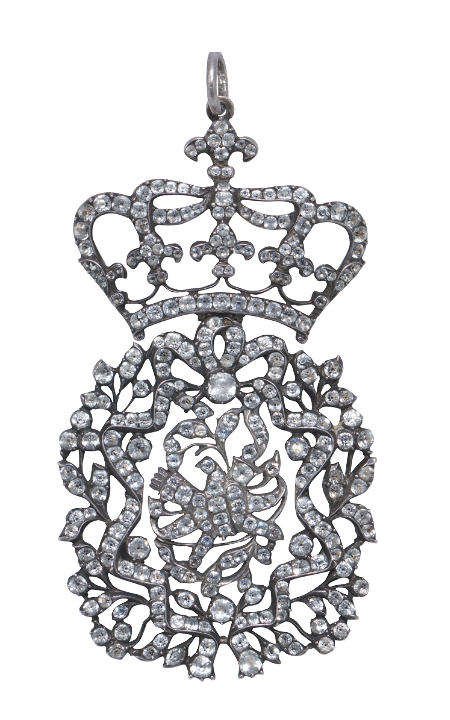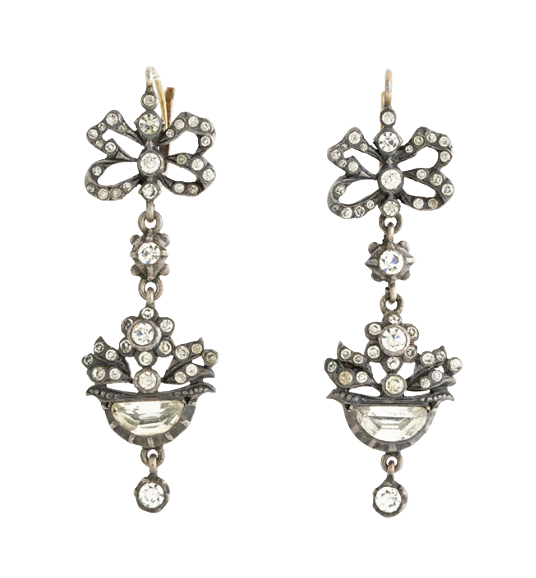Glass has long occupied a marginal position in the hierarchy of jewellery materials, often dismissed as a mere substitute for precious gemstones. Such a view overlooks its historical significance, technical sophistication, and aesthetic value. From the refined craftsmanship of 18th-century Georgian jewellery to its continued use in modern design, glass has served as a versatile medium through which makers experiment with colour, light, and form.
Improvements in glassmaking in the 17th century allowed artisans to create highly refractive, colourless glass called paste, that could convincingly echo the sparkle of diamonds. Quickly becoming popular, by the 18th century, paste had an extraordinary level of refinement under jewellers such as Georges Frédéric Strass, whose name became synonymous with superior imitation stones. Strass’s foiled pastes, admired for their brilliance and precision, were mounted in carefully wrought silver and gold settings that reflected the same attention to detail found in fine jewellery.

The popularity of paste jewellery in the eighteenth century was also shaped by social and economic contexts. Diamonds remained scarce and expensive, and sumptuary laws in certain European courts limited who could wear them. Paste provided a means for a wider clientele namely the rising middle classes, to participate in jewellery adornment. Even members of the aristocracy wore paste, often for travel or in situations where displaying great wealth would be impractical or unsafe, making paste jewellery a practical alternative.
In the 19th century, glass began to occupy an increasingly important place in jewellery design. Advances in glassmaking during the Industrial Revolution made it possible to produce coloured and colourless glass of remarkable clarity and consistency, which coincided with the expansion of a consumer market eager for fashionable adornments at different price points. While glass imitations of emeralds, sapphires, and rubies were popular among the growing middle classes, even high-end jewellers recognised glass’s potential. French houses such as Bapst and later Maison Falize incorporated enamelled and pâte de verre elements into their designs.
By the late nineteenth century, glass became closely associated with the flourishing of the Arts and Crafts and Art Nouveau movements. Jewellers such as René Lalique elevated glass to an entirely new status with a revolutionary use of moulded and enamelled glass which achieved ethereal effects that gemstones could not replicate. Lalique’s dragonflies, orchids, and nymphs, often rendered in opalescent or coloured glass, shifted emphasis away from the intrinsic value of materials toward design, craftsmanship, and symbolism.

Glass continued to play a prominent role in the 20th century, particularly as designers sought to redefine jewellery in response to modernism and changing fashions. During the Art Deco period, jewellers experimented with bold contrasts, pairing rock crystal and frosted glass with diamonds and onyx to create striking geometric compositions. Chanel and other fashion houses popularised costume jewellery that embraced glass elements unapologetically, with ateliers such as Maison Gripoix producing exquisite poured-glass jewels that remain iconic today. These pieces democratized jewellery, making bold design accessible to a wider audience while also influencing high fashion.
From the shimmering pastes of the Georgian era to the experimental forms of contemporary art jewellery, glass has continually bridged imitation and innovation. Its history is one of reinvention, reflecting the evolution of materials and techniques and the cultural desire to express beauty, identity, and imagination through adornment. Far from a secondary medium, glass has proven itself essential to the story of jewellery itself.
By Bethany McGougan, Head of Fine Jewels & Timepieces, Melbourne
Top Image: Pinchbeck and Paste Demi-parure, early 19th century. Sold for $2,500
December 2025
